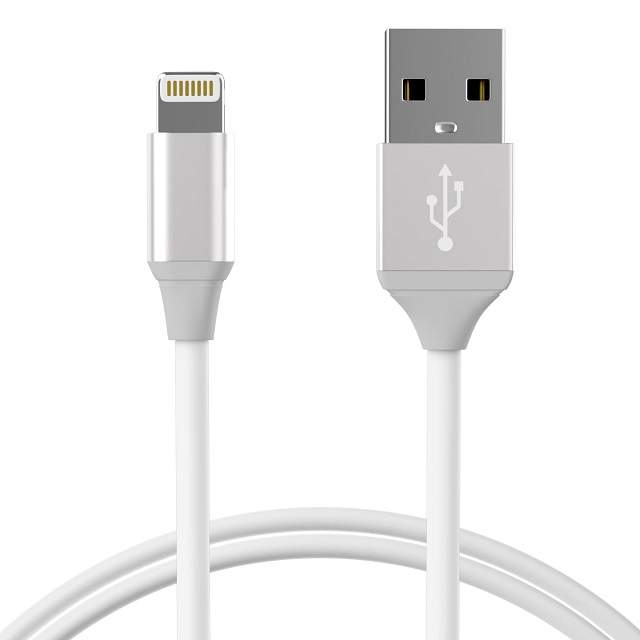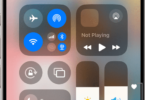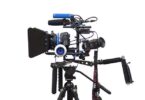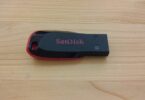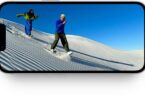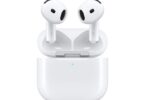USB-C Vs Lightning? What are the differences between these two? Let’s find your answer in this article.
When it comes to charging devices and transferring data, USB-C and Lightning are the two primary cables that are used in recent technologies. Each of them has a broad usage, but their working purpose makes them different. While USB-C is now the industry standard for multiple devices, Lightning cable is used in Apple products.
Apple introduced lightning cables in 2012 to replace the 30-pin connector that was used traditionally. It can offer a reversible plug and comes with a more compact design. On the other hand, the USB Implementers Forum introduced USB-C, which was a development in the USB standard. It is considered as a versatile solution for different devices because of its higher data transfer rates as well as powerful charging capabilities. Let’s dive into the article to learn about USB-C vs lightning in detail.
What is USB-C?
It is basically an industry-standard connector that several devices like laptops and tablets use. This cable is adopted broadly, as it helps to charge various devices as well as transfer data between different devices.
Features:
The features of this cable are as follows:
- High Power Delivery: This cable can carry current upto 3A, whereas the amount rises to 5A when it is used with its supported devices. Its charging power rises upto 100W when you use USB Power Delivery, which is a particular fast-charging protocol. In this case, you should know that the higher charging capability is specific to USB-PD. It isn’t the standard USB-C specification.
- Fast Data Transfer Speeds: While Lightning cables with USB 3.0 support a 5 Gbps data transfer rate, the transfer speed of this cable is up to 10 Gbps. Thus, these cables become suitable for transferring big files.
- Broad Compatibility: These connectors support different devices like smartphones, laptops, and gaming consoles.
Do All USB-C Devices Work The Same Way?
No, USB-C tech is able to support different data & power transfer speeds. All USB-C connectors can support devices which are compatible with USB 2.0, USB 3.0, and USB 3.1. These standards are capable of controlling the data transfer speed. USB 3.0 can offer up to 5 Gbps data transfer rate. However, the speed can be doubled when you use a USB 3.1. Remember that you can determine the speed by the slowest device. Suppose you have plugged the brand new laptop into a hard drive supporting USB 2.0.
Then, the data transfer rate will be a maximum of 480 Mbps. However, you will find the files not moving from one device to another as fast as the speed suggested by the spec. USB 3.1 can transfer data two times quicker than USB 3.0. Compared to USB 2.0, the data transfer rate of USB 3.1 is twenty times faster. On the new MacBook Pros, the USB-C ports are double as Thunderbolt 3 ports. These are compatible with 40 whopping Gbps. In this case, you should know that Thunderbolt 3 and USB-C can be interchanged.
The blue plastic tabs that are available inside the ports can help you identify USB 3.x devices. There are a few USB ports and cables which are compatible with “alternate modes.” With the help of this mode, you can transmit data in forms other than USB. Audio and video formats are examples of such data. That is the reason you can use a USB-C port to connect a DisplayPort monitor to a MacBook.
What Is A Lightning Cable?
It is Apple’s proprietary connector, which indicates that Apple devices primarily use this cable. This kind of cable can provide a secure connection for iPads, iPhones, and iPods. It comes with the capability to limit cross-compatibility with such products that don’t belong to Apple.
Features:
- Reversible Design: These are reversible. Thus, it becomes simpler to plug it into your device.
- Exclusive Compatibility: In order to ensure seamless connection for Apple devices, these cables are made. With the help of this cable, Apple products can deliver better performance.
Both types of cables can offer secure connectivity options for different devices. So, when you want to choose a cable between these two, you need to consider the needs and specifications of your device. Let’s delve into the article to learn about USB-C Vs Lightning in detail.
USB-C Vs Lightning Cable:
We have given here some factors that you need to consider to determine which one you should choose between these two connectors.
-
Charging Speed:
This factor for Universal Serial Bus Type-C relies on the charger and device you are using. Once you have the correct combination, you will experience impressive charging speeds. Suppose a Universal Serial Bus Type-C charger can offer 30 watts. So, it takes only 30 minutes to charge a supported device from 0% to 50%. It is beneficial for those who want their devices to get a quick power boost.
Another best thing is that using a single Universal Serial Bus Type-C cable, you can transfer data quickly as well as connect several devices. All Universal Serial Bus Type-C chargers are not the same. The reason is that a few chargers can offer slower charging speeds. So, you need to use branded chargers and cables that fulfill the required power delivery standards. Besides, a few devices might have particular charging requirements. So, before you charge your device, you need to check your device’s compatibility.
When it comes to lightning connectors, Apple devices can have fast charging speeds using them. These connectors are able to offer rapid charging using the proper charger and cable. Thus, these can fulfill the requirements of those Apple users for whom efficiency and convenience are important.
Apple’s official Lightning cable can quickly charge the supported iPhones and iPads. As a result, it has become a common choice in Apple products, offering a smooth charging experience. Using these connectors allows your devices to get charged up to 50% within thirty minutes. Thus, it helps to increase the battery level quickly when you are traveling. You need to know that third-party Lightning cables cannot feature fast charging. It can affect the entire charging speed. If you are someone who wants fast charging, then you should use certified cables and chargers that can cater to Apple’s standards.
-
Data Transfer Rates:
USB4 is the most recent USB specification, which is compatible with Universal Serial Bus Type-C. The data transfer speed of these cables is up to 40Gbps. But the lightning cables are a lot slower and capable of transferring data at Universal Serial Bus Type-2.0 rates of 480 megabytes per second.
Apple has still not released all specifications for its proprietary technology. Therefore, people are unaware of the maximum data transfer speed of lightning cables. Since this cable was released, the company has not released any protocol update. It indicates that the functionality of the cable changed a little bit since 2012. A cable from 2012 supports new iPhones, which is truly an excellent benefit. Although the Universal Serial Bus Type-C offers a massive speed benefit over the other one, it’s not considered a big advantage, as at present most people share data from their phones wirelessly rather than using a cable.
-
Power Delivery:
When it comes to power delivery, the rate offered by the Universal Serial Bus Type-C is higher compared to the other one and is able to charge your device quickly under the same voltage. The Apple’s connector can carry up to 2.4A current. However, this Universal Serial Bus Type-C connector can carry 3A and is able to support 5A. Because of supporting USB Power Delivery fast-charging standard, the Universal Serial Bus Type-C connector can charge devices quickly.
As standard Lightning cables are not available with the fast charging feature, most Apple products have a USB-C to Lightning Cable. So, using a 20W or higher power adapter, an iPhone’s battery can be half-charged within 30 minutes.
-
Connections And Compatibility:
Both connectors have their individual strengths and weaknesses. Laptops, smartphones, and tablets support the universal standard Universal Serial Bus Type-C. As these ports are now common, it is possible to use the same cable for many devices.
On the flip side, the lightning connector is suitable for iPhones, iPads, iPods, and other Apple devices. Using this connector, you can get a consistent charging and connection option for different Apple devices. However, this cable offers less versatility compared to Universal Serial Bus Type-C in terms of cross-device compatibility.
-
Durability:
When it comes to determining the better one among these two connectors, durability is an important aspect. Each connector comes with a reversible end. Therefore, you can easily use both of them to plug into your devices. The chips available in these two types of connectors ensure that the power supply can be controlled for stabilized current as well as data transfer.
So, which one is more durable? A few people say that Lightning cables get broken more quickly. But other people say that we should use them instead of Universal Serial Bus Type-C to avoid the risk of lose-connection. Also, its connecting tabs can get fitted in a better way in their respective ports. To increase the longevity of the connectors it is essential to buy the connector from a reliable manufacturer. Also, you have to take care of the cable.
-
Reversibility:
Reversible design is a crucial factor that makes Universal Serial Bus Type-C connectors unique. Due to this feature, you can plug this connector both ways. So, you do not need to figure out the correct orientation. As a result, this connector becomes more user-friendly.
However, this feature is also available in the Lightning connector and helps connect Apple devices. But, the disadvantage is that while using lightning, you don’t get the universal compatibility feature offered by Universal Serial Bus Type-C connectors.
-
Relevancy Of Port Shape:
The port shape is a crucial thing you need to consider when determining which one to choose among these two.
The design of the Universal Serial Bus Type-C port is oval. It can provide 24 pins, offering more versatility and functionality. Besides, people using laptops, Android devices, etc., use this connector because of its wider compatibility. Also, this one is popular for its faster charging capabilities and faster data transfer rates.
On the flip side, the other one comes in a smaller shape and can be found on Apple’s iPhones and other iOS devices. Eight pins are available on every side. Thus, it becomes simpler to insert into the port of your device. It is especially made for iPhones and iPads with slim profiles and helps maintain a secure connection.
If you want to choose any of these connectors, you need to consider the compatibility of the device. Also, you need to consider the physical space and connections needed. Each port shape has individual characteristics. Therefore, you need to choose between these two based on what your requirements are.
-
Accessories And Adapters:
You can enhance the connectivity of your device using different adapters and accessories. With the help of adapters, you are capable of connecting your device to various external devices like displays, external storage devices, or other connectors. If you are willing to connect a USB-C device to a monitor or TV, you are required to use a USB-C to HDMI adapter. On the other hand, if your iPhone does not have a headphone jack, you will need a Lightning to 3.5mm headphone jack adapter.
Thunderbolt 3 is a high-speed interface that is capable of using a Universal Serial Bus Type-C connector which supports different types of accessories & displays and can transfer data quickly. This connector is used by Thunderbolt 3 and 4, which support some Universal Serial Bus Type-C devices. However, not all devices using this connector are compatible with Thunderbolt; so, before you connect any Thunderbolt accessory, you have to ensure compatibility.
Dongles are compact adapters that can offer extra connectivity options to those devices that have limited ports. For instance, you can see a USB-C dongle providing several USB-A ports, an SD card reader, and an HDMI port. When it comes to Lightning dongles, you are capable of connecting to USB-A devices or standard 3.5mm headphones.
If you are willing to charge your device and attach the charging cables magnetically, then you must go with Apple’s MagSafe technology. In its initial stage, MacBook chargers used this technology. But later, iPhones started using this technology. But this technology is not available for Universal Serial Bus Type-C devices.
-
Manufacturers And Regulatory Bodies:
Apple is the primary user and manufacturer of lightning connectors. In 2012, it was introduced. This connector was a successor to the 30-pin dock connector. Later, the company adopted USB-C technology for MacBooks and iPad Pros. However, the company still uses lightning in iPhones, iPads, and other accessories.
Due to the versatile nature of Universal Serial Bus Type-C, other manufacturers have started using it. Google, Samsung, and Microsoft use this connector in tablets, smartphones, and laptops. It indicates that the connector is accepted widely across different platforms. USB-IF, which stands for USB Implementers Forum, develops USB standards. This non-profit organization ensures that USB devices are compatible with certifying products as per the specified guidelines.
Apple and other manufacturers contributed to the landscape of these two connectors. Meanwhile, USB-IF, the European Union, and other regulatory bodies assist in governing the development as well as implementation.
-
Reliability:
Apple uses a chip in its proprietary connector, and it is the only company doing so. The main motive behind this is to ensure the safety as well as the quality of the thread. Thread is a crucial security requirement for any yarn and ensures that Apple devices and accessories are compatible with each other. The chip helps to make a lightning cable safer compared to a non-MFi Lightning cable. But it does not indicate that you can trust this one more than a Universal Serial Bus Type-C cable.
A full-featured USB-C cable needs to be available with an E-Marker chip. This chip can identify data between devices using the Configuration Channel. Thus, it helps to control the power supply. When you use the fast charging feature, you need to protect your USB devices. As the Universal Serial Bus Type-C connector needs to handle fast charging, it comes with extra safeguards.
-
Adapter Support:
Universal Serial Bus Type-C connector uses a simple passive adapter to connect you to older USB-A devices. But the other one needs powered adapters and has no support for the previous 30-pin connectors. It helps the Universal Serial Bus Type-C connector to become widely backward compatible.
-
Audio And Video Output:
The Universal Serial Bus Type-C alternate mode permits direct video output to displays as well as monitors. However, specific VGA output from the iPhone or AV adapters for HDMI is essential for the other one.
USB-C vs Lightning Cable- Future Developments in Charging Technology:
-
Upcoming Changes In USB-C Technology:
New advancements and features will continue to be available in the Universal Serial Bus Type-C standard. And the introduction of USB4 is one of the future developments among them. It can offer enhanced power delivery capabilities and faster data transfer speeds. This new advancement uses the existing USB-C infrastructure to be built upon.
In this way, it is capable of acting as a versatile charging solution for those devices that will be available in the future. The implementation of GaN or gallium nitride chargers is also a great improvement in this technology. While the chargers offer more efficiency, these are available in small sizes. In addition, these create less heat than traditional silicon-based chargers. You can expect them to be more prevalent in the future, allowing you to get a powerful charging solution.
-
Upcoming Changes In Lightning Technology:
Although these connectors are proprietary to Apple, the company could be seen transiting to the Universal Serial Bus Type-C connector for its devices. However, it is just based on speculation. In addition, the company’s plan has not yet been disclosed publicly. So you need to wait to see when any change happens. The company may adopt wireless charging technology as a primary method of powering devices, helping to eliminate the requirements of physical connectors.
USB-C Vs Lightning: Which One Is Better?
If the phone has both ports, it is better to plug in a USB-C cable. While this connector can transfer data, it is capable of transmitting more power. Thus, it is possible to charge the phone more quickly. However, the lightning has become an outdated standard because of the company’s tech ecosystem’s isolation and Apple products’ relatively low power requirements.
The MacBook is one of the most powerful devices which uses the USB standard in an excellent way. The company refused and did not upgrade the charging ports of the iPhone. So, let’s see what happens in the future whether Apple upgrades the charging ports of the iPhones or adopts the wireless charging method.
Why Did Apple Insist On Lightning?
In order to transfer data and charge devices, almost all Android smartphones use the Universal Serial Bus Type-C connector. In contrast, the lightning connector was there for the iPhone series between 2012 and 2022 despite the other devices of the company having migrated to USB-C. Although Apple never revealed the reason for doing so, it is thought that the company is willing to maintain backward compatibility with several years’ worth of the company & the third-party accessories of iPhone.
With the help of the Lightning connector, the company earned licensing fees through the MFi or Made For iPhone/iPad program. Third-party accessory makers need to abide by a few specific rules. Thus, Apple gets more control over the Lightning ecosystem. On the other hand, manufacturers are capable of implementing Universal Serial Bus Type-C and Power Delivery and they do not need to pay any licensing fees.
The main issue with the USB-C connector is its terminology. Now you know the difference between these standards like USB-C, USB 3, USB 3.2 Gen 1, Thunderbolt 3, etc. So, if you are confused and want to get rid of the confusion, you should go for a Lightning cable. If it was not enough, then you should know that USB-IF continues to rename the established Universal Serial Bus standards, seemingly on a whim. However, you can get the required clarity from the USB 3.x standards chart.
The Bottom Line:
The device that is getting charged helps to determine the power flowing through a Universal Serial Bus Type-C connector. 240 watts is the maximum power, which is sufficient and can easily charge most laptops. There are several Universal Serial Bus Type-C chargers available that are capable of offering only 45 or 60 watts. In this article, we have discussed USB-C Vs Lightning. In every aspect, the Universal Serial Bus Type-C beats the Lightning connector and can provide broad compatibility & quicker data transfer rate.

